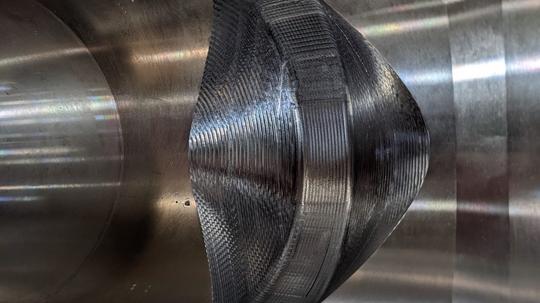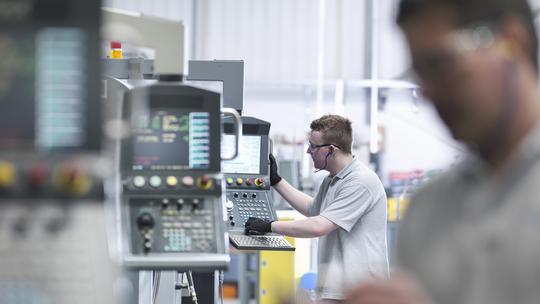
A new reality is emerging in precision machining. Technology is evolving. Demand for customization is growing. Lead time are becoming shorter. And tolerances are tightening. But over the next decade, manufacturing is poised to experience the biggest (and fastest) transformation since the Industrial Revolution.
Momentum within the space has been mounting since the early 2000s; but the spark to the powder keg occurred in 2020: the COVID-19 pandemic.
The COVID-19 pandemic has fundamentally altered the way we live, work, and relate to one another. For the precision machining industry, the pandemic has drastically impacted businesses and operations, and the effects will last.
Here are key trends on the horizon that will completely change the direction of precision machining in the next 10 years.
1. Automation will become indispensable
Although increasing automation has long been a trend within precision machining and manufacturing, the pandemic exposed the high cost of unforeseen disruptions in production. Many plants and facilities were forced to limit the number of onsite personnel for months at a time. Under these circumstances, having an operator for every machine is no longer feasible.
“To become adaptable in the future, companies must adopt more machines and tools with advanced automation,” says Justin Tripp, vice president of engineering at Tri Tool Technologies, a global leader in the design and manufacture of high-performance, precision machine tools and custom engineered solutions for major industrial markets. “Right now, it’s difficult to find good operators of machinery. With manufacturing on the rise, automation will help companies keep pace.”
2. The industrial Internet of Things (IIoT) will dominate emerging technology
The pandemic also underscores the value of IIoT technology in computer numerical control (CNC) machines. Through embedded sensors on CNC machines, IIoT allows for the real-time monitoring of conditions, sending alerts or notifications to operators whenever tuning or maintenance is due.
IIoT also has the potential to establish machine-to-machine synchronization, resulting in reduced manual efforts and improved worker safety. While the IoT itself is nothing new, it has only recently found its way into the precision computing of the CNC machining industry and can help making manufacturing processes faster, safer, and of higher quality.

3. The adoption of 6-axis machining will rapidly expand
For years, the 3-axis milling machine was the go-to system. However, the need for more detailed cutting within the manufacturing industry has given way to 4-axis and 5-axis milling machines, which perform seamless rotations around the X and Y axes for greater precision, more operations, and fewer setups.
Yet, the 6-axis milling machine is slated to be the champion of the next decade. Capable of rotating around the Z axis, 6-axis milling machines offer a significant improvement in setup and cutting speed, as well as unprecedented precision.
4. Tooling will become more specialized and ultra-precise
In the next 10 years, manufacturing and fabrication facilities will move toward custom onsite tool manufacturing to increase production and accuracy and eliminate downtime while waiting on a new or refurbished tool to arrive from another facility.
“As manufacturing becomes more specialized, so too does the equipment, tools, and machines,” says Alex Muhs, Tri Tool’s head of operations. “When companies can’t find an off-the-shelf solution for a difficult machining application, or when a project requires machining in a remote location, they need a machining partner who can deliver custom engineered solutions whenever and wherever they need it.”
5. There will be an increased focus on reducing waste product
The COVID-19 pandemic sent supply chains worldwide into a tailspin. While raw materials have always been a precious resource, the next decade will be marked by increased attention to wise materials usage.
One strategy is creating scale models of components using 3D printing methods rather than experimenting with design on actual equipment. 3D printers also have the potential to manufacture parts and tools that are unavailable due to a disrupted supply chain. Switching to alternative manufacturing methods is sometimes the only way a part can get to where it’s needed, when it’s needed.

While we don’t know for sure what precision machining will look like 10 or 20 years from now, we do know that change is inevitable. The pandemic has shown us how complex and sensitive the precision machining industry is. One global event sparked a decade of transformation.
Across all sectors — aerospace, government and defense, life sciences, power generation, oil and gas, and semiconductor — the pandemic gives you the opportunity to revisit the current operations of your factory, plant, or production facility to determine how you can make them more agile, efficient, and safe. As we navigate the next normal, precision, partnership, and innovation will give you the edge.
Learn how Tri Tool is leading the transformation of the precision machining industry at www.tritool.com.
Tri Tool is a global leader in the design and manufacture of custom MissionBuilt™ engineered solutions and high-performance PurposeBuilt™ precision machine tools for major industrial markets, including aerospace, government and defense, life sciences, power generation, oil and gas, and semiconductor.
